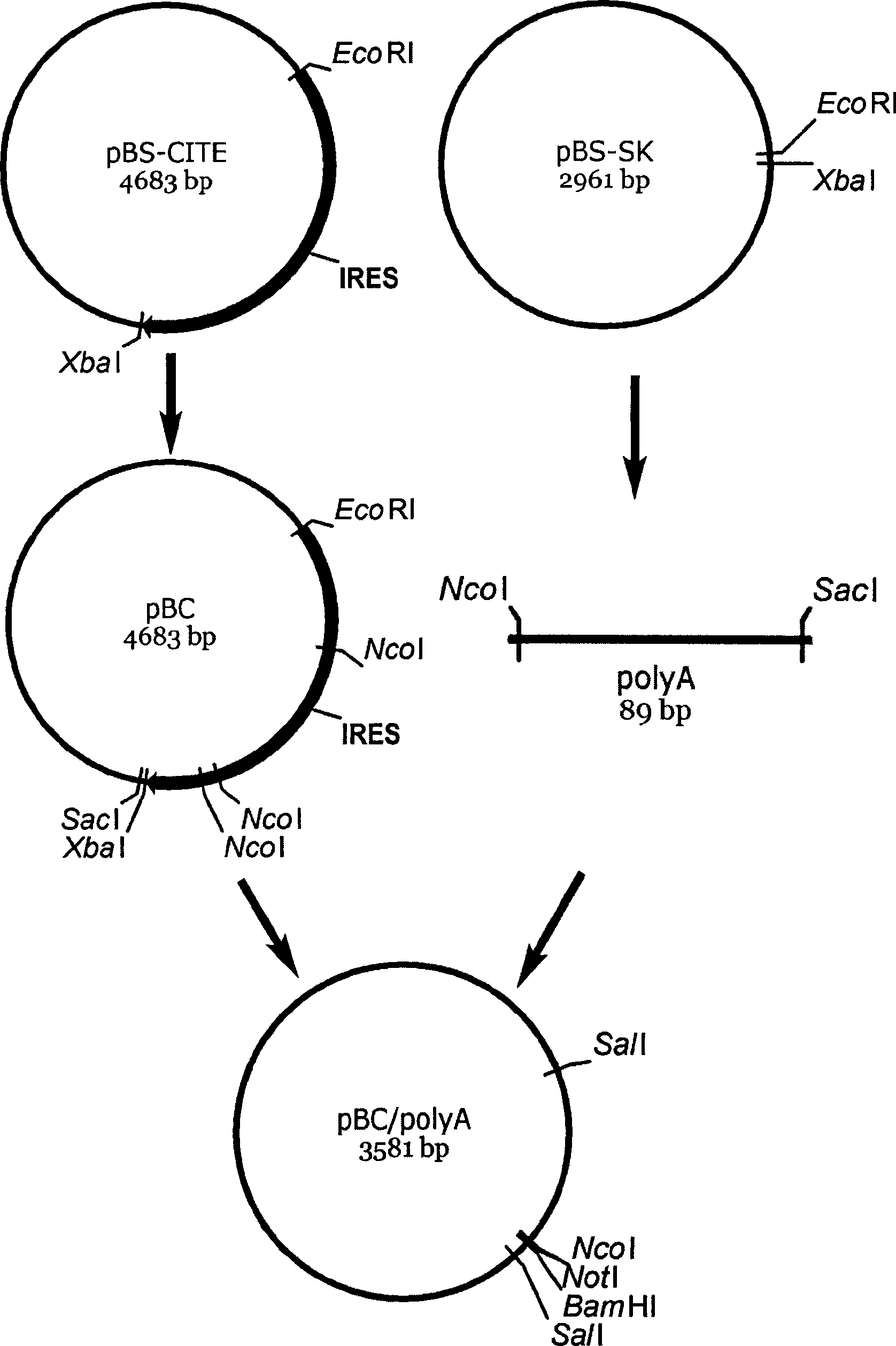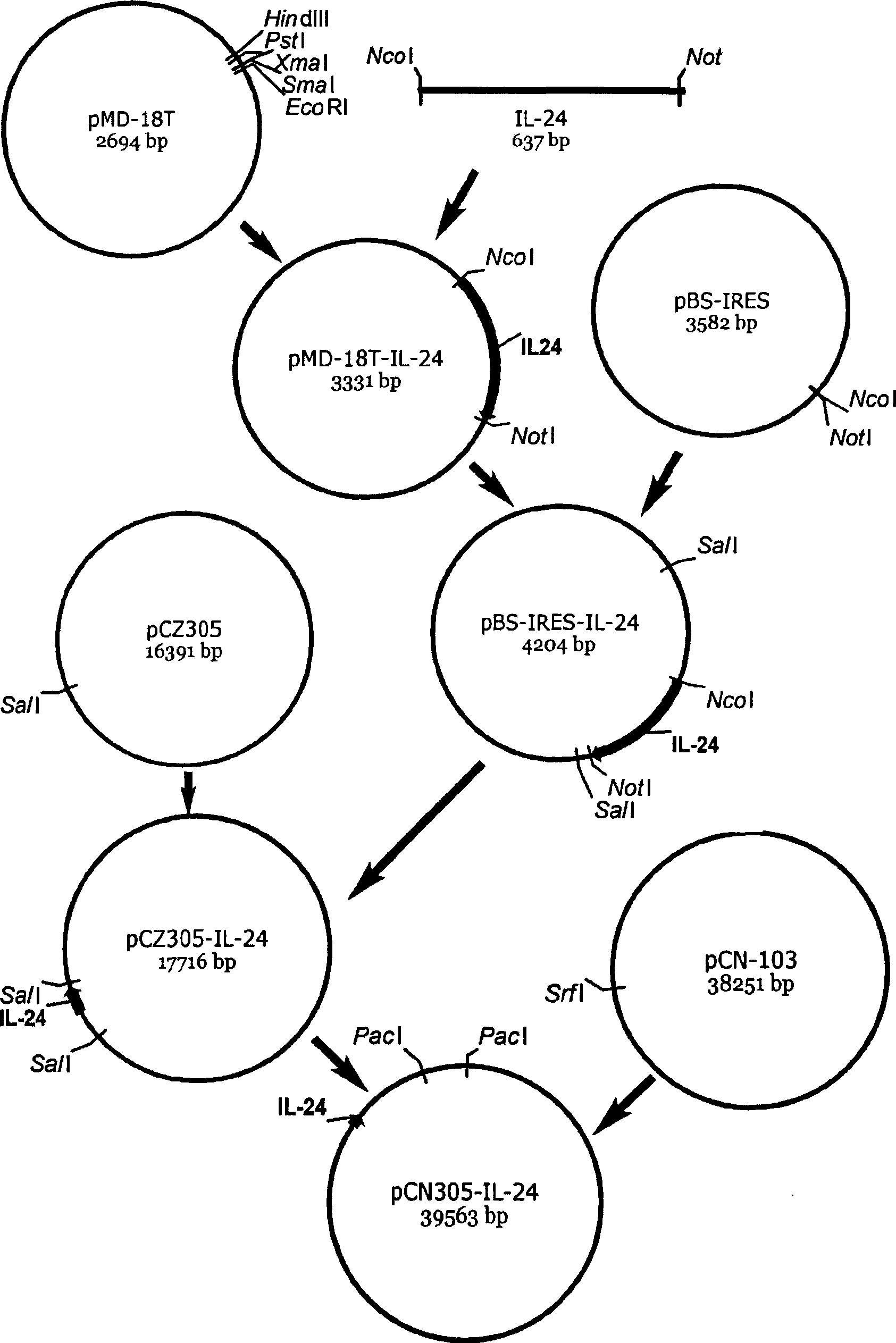Late promoter targeting regulation oncolytic adenovirus pCN305 vector and construction method and application thereof
An oncolytic adenovirus and late promoter technology, which is applied in the field of construction of dual-targeted oncolytic adenovirus vectors, can solve the problems of hindering the clinical efficacy of tumor gene therapy, unable to completely kill tumor cells, and unable to treat the high-efficiency expression of genes. , to achieve good tumor killing effect, enhance killing ability, and enhance the effect of safety
- Summary
- Abstract
- Description
- Claims
- Application Information
AI Technical Summary
Problems solved by technology
Method used
Image
Examples
Embodiment 1
[0078] Construction of tumor-targeted adenoviral vector PCN305 carrying exogenous genes and obtaining viruses such as AdCN305-IL-24, AdCN305-SOCS3 and AdCN305-cpp-SOCS3. A. Construction of transfer plasmid pCZ305:
[0079] First design the following primers:
[0080] Ad66:5'CCAGAATATTGGAACTTTAG 3'
[0081] BYZGR
[0082] Ad67:5'GGATCCATCGAGGATCCTCATTCTTGGGCAATGTATGAA 3'
[0083] BamHI
[0084] Ad68: 5'GGATCCGTCGACTCGCGAGAATCGTTTGTGTTATGTT 3'
[0085] BamHI
[0086] Ad69:5'CTTAAGTGAGCTGCCCGGGGA 3'
[0087] AflII
[0088] ① Construct transfer vector pCZ301:
[0089] Plasmid pTG1801 was digested with HindIII, and the 2937bp fragment was recovered by electrophoresis after complete digestion. This fragment was ligated and transformed with the vector pGEM-11Zf(+) which was also digested with HindI II and dephosphorylated, and the correct positive clone was taken and named pCZ301.
[0090] ② Construction of transfer vector pCZ302:
[0091]Using ...
Embodiment 2
[0108] Example 2: Expression ability in SOCS3 cells after virus infection.
[0109] The virus AdCN305-SOCS3 was used to infect five kinds of cells including MRC5, BEL7404, Hep3B, H460 and Bcap37 at 5 MOI respectively. After 48 hours, the total protein of the cells was extracted, and the expression of SOCS3 protein was analyzed by Western-blot. Such as Figure 4 As shown, from left to right, AdCN305-SOCS3 expresses SOCS3 in human embryonic lung cell MRC5, human liver cancer cell line BEL7404, human liver cancer cell line Hep3B, human lung cancer cell line H460, and human breast cancer cell line Bcap37. Level. In normal cell MRC5, the expression level of SOCS3 protein was low, indicating a low virus replication rate. In the four tumor cells, the expression level of SOCS3 protein was higher, indicating a higher rate of virus replication.
Embodiment 3
[0110] Example 3: SOCS3 induces tumor cell apoptosis.
[0111] Viruses Ad-wt, AdCN305-SOCS3 and AdCN305-cpp-SOCS3 were used to infect human lung cancer cells H460 at 5 MOI. After 48 hours of treatment, the ability of SOCS3 to induce tumor cell apoptosis was detected by Hochest staining. Such as Figure 5 Shown, where, a represents the Hochest staining of PBS blank control group, b represents the Hochest staining after Ad-wt acts on H460 cells, c represents the Hochest staining after AdCN305-SOCS3 acts on H460 cells, d represents AdCN305-cpp-SOCS3 acts on H460 cells Cells were stained by Hochest. It can be seen that the viruses AdCN305-SOCS3 and AdCN305-cpp-SOCS3 can induce tumor cell apoptosis, but PBS and Ad-wt did not induce tumor cell apoptosis. (Arrows point to apoptotic cells)
PUM
 Login to View More
Login to View More Abstract
Description
Claims
Application Information
 Login to View More
Login to View More - R&D
- Intellectual Property
- Life Sciences
- Materials
- Tech Scout
- Unparalleled Data Quality
- Higher Quality Content
- 60% Fewer Hallucinations
Browse by: Latest US Patents, China's latest patents, Technical Efficacy Thesaurus, Application Domain, Technology Topic, Popular Technical Reports.
© 2025 PatSnap. All rights reserved.Legal|Privacy policy|Modern Slavery Act Transparency Statement|Sitemap|About US| Contact US: help@patsnap.com



